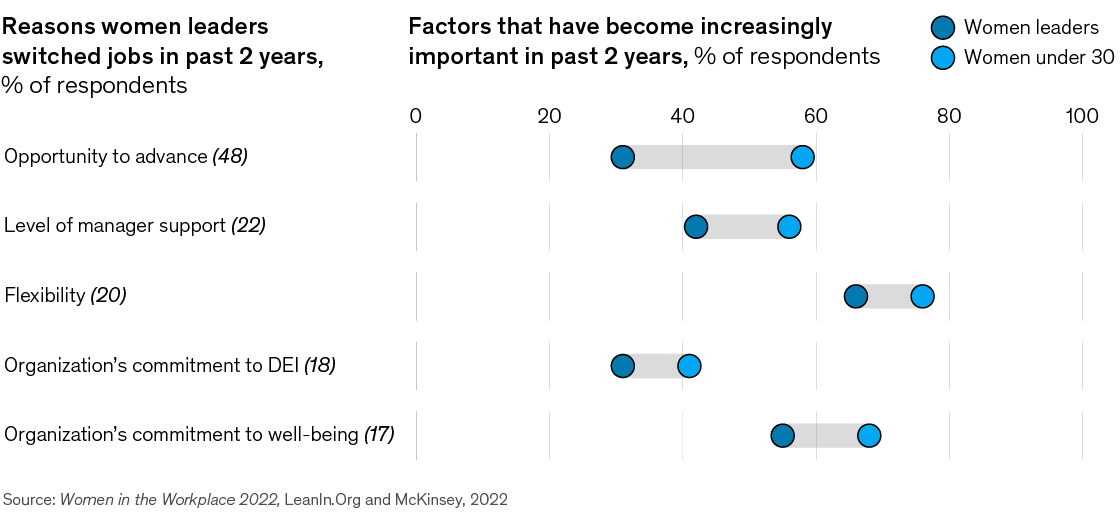| | |
 |
Edited by Justine Jablonska
(she/her/hers)
Editor, New York |
|
|
|
|
| |
|
Insights and strategies to nurture diversity, equity, and inclusion in the workplace. In your mailbox every two weeks.
|
|
|
First, there was the Great Attrition. Now, there’s the “Great Breakup”: women leaders, already underrepresented in organizations, are quitting at the highest rates we’ve ever seen. In this issue, we explore the implications for organizations that are struggling to retain the relatively few women leaders they have, as well as how intersectionality deepens these dynamics. Check out our experts’ views on how companies can take action to support not only their current senior-level women but also the next generation of women leaders. Plus, a look at how to reestablish connections purposefully in today’s changed workplaces.
|
|
|
| |
|
Women want more from work.
And they’re switching jobs to get it.
|
|
|
| |
|
| |
Why are so many women leaving their jobs? They’re facing persistent and strong headwinds when it comes to advancement. And women—especially women of color, LGBTQ+ women, and women with disabilities—are more likely to experience harmful, belittling microaggressions in the workplace. Those are among the startling findings in Women in the Workplace 2022, the largest annual study of women in corporate America, conducted by McKinsey in partnership with LeanIn.Org. The report, coauthored by McKinsey senior partners Alexis Krivkovich and Lareina Yee and other McKinsey experts, presents information from 333 participating organizations employing more than 12 million people, surveys from more than 40,000 employees, and extensive interviews with women of diverse backgrounds to gain a better perspective on intersectionality at work. What the results reveal could have grave implications for organizations, which risk losing not just the women leaders they now have but also the next generation of women leaders—since our research shows that younger women are increasingly placing higher premiums on equitable, inclusive, and supportive workplaces.
|
|
|
| |
| |
| | | |
|
The factors that prompt current women leaders to leave their companies are even more important to the next generation of women leaders. |
|
| |
| |
|
| |
We sat down with McKinsey partner Ishanaa Rambachan, coauthor of Women in the Workplace 2022, to delve deeper into the report’s findings.
1. What is your biggest takeaway from this report?
It’s the scale of the Great Breakup, with women leaders leaving their companies at rates we’ve never seen before, and at higher rates than men in leadership roles. To put the scale of this problem into perspective: for every one woman director getting promoted to the next level, two women directors are leaving their current jobs. But what’s interesting is that according to our data, these women aren’t leaving the workforce entirely. Instead, they’re making deliberate choices about where they are choosing to work—and some are even switching industries or perhaps becoming entrepreneurs.
2. Did anything in the results surprise you?
Women remain deeply underrepresented in technical roles, and this problem seems to be getting worse, with a lower relative representation of women in these jobs than in 2018. Women in technical roles today are twice as likely to say they’re the only woman in the room at work. Why does this matter? Engineering and technical roles are among corporate America’s fastest-growing and highest-paying jobs. It’s important that we increase the representation of women in technical roles, improve their experiences in these roles, and create equal paths to advancement in order to ultimately improve representation.
Another interesting and positive finding is that ambition remains high. Young women want the same things that are driving women leaders to leave at such high rates. It’s good to see that young women are ambitious, bold, and willing to take a stand for what they want in their workplaces. It’s encouraging for the future.
3. Are there any findings that particularly resonated with you?
So many, but two in particular.
The first is the experience of women of color. Only one in 20 C-suite leaders is a woman of color, compared with one in four C-suite leaders for all women. Additionally, for women of color, biases and microaggressions loom large. I hope to see progress on this important issue, not only for myself, my colleagues, and my team but also for my twin toddler daughters as they move forward in the world.
I’m also struck by the paradox of flexibility. The vast majority of employees, both men and women, appreciate flexibility. As a working parent, I especially do. At the same time, I find in-person presence valuable; I enjoy being able to spend time with clients, team members, and colleagues. Getting that balance right is a uniquely challenging opportunity for this particular time.
|
|
| |
| |
|
| |
| |
| |
| |
| |
|
Connectivity in the workplace, or social capital, can help employees learn, flex their creative and collaborative skills, and even advance. But in today’s postpandemic workplaces, where remote work is widespread, social capital can be in short supply. It can, however, be reestablished and rebuilt, according to McKinsey’s John Parsons and Brooke Weddle. Listen to a recent episode of The McKinsey Podcast to learn more about the state of social capital today and how leaders can intentionally and thoughtfully manage workplace interactions. |
|
| |
| |
|
|
|
Do any of the findings from our Women in the Workplace research particularly resonate with you? |
|
|
|
|
| |
| |
|
| |
| | | |
This email contains information about McKinsey's research, insights, services, or events. By opening our emails or clicking on links, you agree to our use of cookies and web tracking technology. For more information on how we use and protect your information, please review our privacy policy. |
|
You received this email because you subscribed to the Intersection newsletter. |
|
|
Copyright © 2022 | McKinsey & Company, 3 World Trade Center, 175 Greenwich Street, New York, NY 10007 |
|
|
|
|
|





